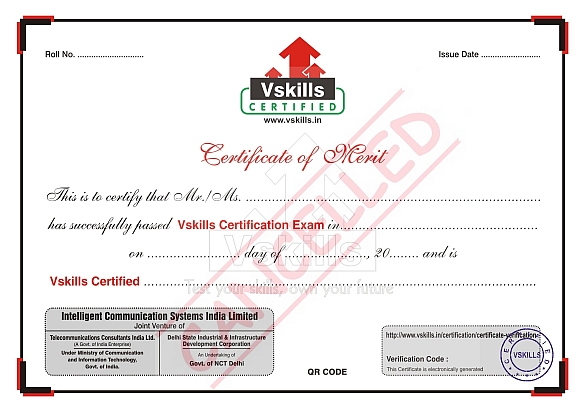- مدة الدورة التدريبية: 1 To 2 Months إبدأ الآن
- الشهادة:
- طريقة تقديم الدورة: عبر عرض الفيديو
تفاصيل الدورة
Vskills Django Developer certification assesses the candidate for development of website and web applications by using the Django framework. The certification tests the candidates on various areas in Django which includes installation, basics, management and customization of Django framework for development of website and web applications.Knowledge of Python is pre-requisite for certification.
Why should one take this certification?
This certification is intended for professionals and graduates wanting to excel in their chosen areas. It is also well suited for those who are already working and would like to take certification for further career progression.
Earning Vskills Django Developer Certification can help candidate differentiate in today's competitive job market, broaden their employment opportunities by displaying their advanced skills, and result in higher earning potential.
For employers, the certification provides skill verification tool that help assess a person's skills in django.
Who will benefit from taking this certification?
Job seekers looking to find employment in various software and IT infrastructure companies, students generally wanting to improve their skill set and make their CV stronger and existing employees looking for a better role can prove their employers the value of their skills through this certification.
Table of Contents
Introduction
- What Is a Web Framework?
- MVC
- Django Evolution
- Getting Help
- Installation
- Database Setup
- Starting a Project
- Your First View: Dynamic Content
- Mapping URLs to Views
- How Django Processes a Request
- URLconfs and Loose Coupling
- 404 Errors
- Your Second View: Dynamic URLs
- Django’s Pretty Error Pages
- Template System Basics
- Using the Template System
- Basic Template Tags and Filters
- Philosophies and Limitations
- Using Templates in Views
- Template Inheritance
- The “Dumb” Way to Do Database Queries in Views
- The MTV Development Pattern
- Configuring the Database
- Your First App
- Defining Models in Python
- Your First Model
- Installing the Model
- Basic Data Access
- Inserting and Updating Data
- Selecting Objects
- Making Changes to a Database Schema
- Activating the Admin Interface
- Using the Admin Interface
- Customizing the Admin Interface
- Customizing the Admin Interface’s Look and Feel
- When and Why to Use the Admin Interface
- Search
- The “Perfect Form”
- Processing the Submission
- Custom Validation Rules
- A Custom Look and Feel
- Creating Forms from Models
- URLconf Tricks
- Including Other URLconfs
- Using Generic Views
- Generic Views of Objects
- Extending Generic Views
- Template Language Review
- RequestContext and Context Processors
- Inside Template Loading
- Extending the Template System
- Writing Custom Template Loaders
- Using the Built-in Template Reference
- Configuring the Template System in Standalone Mode
- The basics: views and MIME-types
- Producing CSV
- Generating PDFs
- Other Possibilities
- The Syndication Feed Framework
- The Sitemap Framework
- Cookies
- Django’s Session Framework
- Users and Authentication
- The Other Bits: Permissions, Groups, Messages, and Profiles
- Setting Up the Cache
- The Per-Site Cache
- The Per-View Cache
- The Low-Level Cache API
- Upstream Caches
- Other Optimizations
- Order of MIDDLEWARE_CLASSES
- The Django Standard Library
- Sites
- Flatpages
- Redirects
- CSRF Protection
- Humanizing Data
- Markup Filters
- What’s Middleware?
- Middleware Installation
- Middleware Methods
- Built-in Middleware
- Integrating with a Legacy Database
- Integrating with an Authentication System
- Integrating with Legacy Web Applications
- The Zen of Admin
- Customizing Admin Templates
- Creating Custom Admin Views
- Overriding Built-in Views
- Specifying Translation Strings in Python Code
- Specifying Translation Strings in Template Code
- Creating Language Files
- How Django Discovers Language Preference
- The set_language Redirect View
- Using Translations in Your Own Projects
- Translations and JavaScript
- The Theme of Web Security
- SQL Injection
- Cross-Site Scripting (XSS)
- Cross-Site Request Forgery
- Session Forging/Hijacking
- Email Header Injection
- Directory Traversal
- Exposed Error Messages
- A Final Word on Security
- Shared Nothing
- A Note on Personal Preferences
- Using Django with Apache and mod_python
- Using Django with FastCGI
- Scaling
- Performance Tuning
نبذة عن معهد Vskills
Vskills is the largest certification body of India. It conducts skills testing and certification exam to improve employability. Candidates use Vskills Certifications, which are well recognized in the Industry, as certification of skills and knowledge.
Companies have benefitted by hiring pre-certified candidates from Vskills and also use the certifications for their in
house employee appraisals. The certification body is affiliated to various organizations and is managed professionally by IIM Alumni.
Tests are conducted in a secure and unbiased manner, and certificates are awarded based on merit of the candidates who qualify tests.
Vskills certifications are for relevant qualifications that help students/employees quantify and prove those skills that are valued by the employer and are in great demand.





